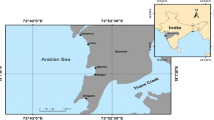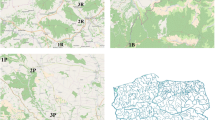Abstract
Bacterial resistance is a rising problem all over the world. Many studies have showed that beach sands can contain higher concentration of microorganisms and represent a risk to public health. This paper aims to evaluate the densities and resistance to antimicrobials of Escherichia coli strains, isolated from seawater and samples. The hypothesis is that microorganisms show higher densities in contaminated beach sands and more antimicrobial resistance than the water column. Density, distribution, and antimicrobial resistance of bacteria E. coli were evaluate in seawater and sands from two recreational beaches with different levels of pollution. At the beach with higher degree of pollution (Gonzaguinha), water samples presented the highest densities of E. coli; however, higher frequency of resistant strains was observe in wet sand (71.9 %). Resistance to a larger number of antimicrobial groups was observe in water (betalactamics, aminoglycosides, macrolides, rifampicins, and tetracyclines) and sand (betagalactamics and aminoglycosids). In water samples, highest frequencies of resistance were obtain against ampicilin (22.5 %), streptomycin (15.0 %), and rifampicin (15.0 %), while in sand, the highest frequencies were observe in relation to ampicilin (36.25 %) and streptomycin (23.52 %). At the less polluted beach, Ilha Porchat, highest densities of E. coli and higher frequency of resistance were obtain in wet and dry sand (53.7 and 53.8 %, respectively) compared to water (50 %). Antimicrobial resistance in strains isolated from water and sand only occurred against betalactamics (ampicilin and amoxicilin plus clavulanic acid). The frequency and variability of bacterial resistance to antimicrobials in marine recreational waters and sands were related to the degree of fecal contamination in this environment. These results show that water and sands from beaches with a high index of fecal contamination of human origin may be potential sources of contamination by pathogens and contribute to the dissemination of bacterial resistance.





Similar content being viewed by others
References
Alm, E., Burke, J., & Spain, A. (2003). Fecal indicator bacteria are abundant in wet sand at freshwater beaches. Water Research, 37, 3978–3982.
APHA, American Public Health Association. (2012). Standard Methods for the Examination of Water and Wastewater. APH, AWWA, WEF. 22th Edition. 1120p.
Arvanitidou, M., Katsouyannopoulos, V., & Tsakris, A. (2001). Antibiotic resistance patterns of enterococci isolated from coastal bathing waters. Journal of Medical Microbiology, 50, 1001–1005.
Ashbolt, N. J., Kueh, C. S. W., & Grohmann, G. S. (1993). Significance of specific bacterial pathogens in the assessment of polluted receiving water of Sydney, Australia. Water Science and Technology, 27(3-4), 449–452.
Bartram, J., & Rees, G. (2000). Monitoring Bathing Waters. London: E & FN Spon. Brasil. Conselho Nacional do Meio Ambiente - CONAMA. Dispõe sobre a sistemática de avaliação da qualidade ambiental das águas. Resolução CONAMA n 274, de 29 de novembro de 2000. Diário Oficial da União, República Federativa do Brasil, Brasília, DF., 8 jan. 2001.
Brunke, M., & Fischer, H. (1999). Hyporheic bacteria—Relationships to environmental gradients and invertebrates in a prealpine stream. Archives Hydrobiology, 146, 189–217.
CETESB - Companhia de Tecnologia e Saneamento Ambiental. (2006). Relatório de qualidade das águas litorâneas do Estado de São Paulo: balneabilidade das praias 2005. São Paulo: Companhia de Tecnologia de Saneamento Ambiental.
CETESB, Companhia de Tecnologia e Saneamento Ambiental. (2008). Relatório de qualidade das águas litorâneas do Estado de São Paulo: Balneabilidade das praias 2007. São Paulo: Companhia de Tecnologia de Saneamento Ambiental.
CETESB, Companhia de Tecnologia e Saneamento Ambiental. (2012). Variáveis de qualidade das águas. São Paulo: Companhia de Tecnologia e Saneamento Ambiental.
CONAMA, Conselho Nacional do Meio Ambiente. (2000). Resolução n.274, Recomenda a adoção de sistemáticas de avaliação de qualidade das águas. Brazil: Conselho Nacional do Meio Ambiente.
Constanzo, S. D., Murby, J., & Bates, J. (2005). Ecosystem response to antibiotics entering in the aquatic environment. Marine Pollution Bulletin, 51, 218–223.
Dada, A. C., Ahmad, A., Usup, G., & Heng, Y. (2013). Speciation and antimicrobial resistance of Enterococci isolated from recreational beaches in Malaysia. Environmental Monitoring and Assessment, 185, 1583–1599.
Daughton, C. G., & Ternes, T. A. (1999). Pharmaceuticals and personal care products in the environment: Agents of subtle change? Environmental Health Perspectives, 107, 907–938.
Davies, C. M., & Bavor, H. J. (2000). The fate of storm water associated bacteria in constructed wetland and water pollution control pond systems. Journal of Applied Microbiology, 89(2), 349–460.
Davies, C. M., Long, J. A. H., Donald, M., & Ashbolt, N. J. (1995). Survival of fecal microorganism in marine and freshwater sediments. Applied Environmental Microbiology, 61(5), 1888–1896.
Davies-Colley, R. J., Donnison, A. M., Speed, D. J., Ross, C. M., & Nagels, J. W. (1999). Inactivation of fecal indicator microorganisms in wate stabilization ponds: Interactions of environmental factors with sunlight. Water Research, 33(5), 1220–1230.
Elmanama, A. A., Fahd, M. I., Abdallah, A. S., & Bahr, S. (2005). Microbiological beach sand quality in Gaza Strip in comparison to seawater quality. Environmental Research, 99, 1–10.
Frieden, T. R., Munsiff, S. S., Low, D. E., Willey, B. M., Williams, G., Faur, Y., et al. (1993). Emergence of vancomycin-resistant enterococci in New York city. Lancet, 324, 76–79.
Galvin, S., Boyle, F., Hickey, P., Vellinga, A., Morris, D., & Cormican, M. (2010). Enumeration and characterization of antimicrobial-resistant Escherichia coli bacteria in effluent from municipal, hospital, and secondary treatment facility sources. Applied and Environmental Microbiology, 76, 4772–4779.
Ghinsberg, R., Dov, L. B., Rogol, M., Sheinberg, Y., Nitzan, Y. (1994). Monitoring of selected bacteria and fungi in sand and sea water along the Tel Aviv coast. Microbios, 77, 29–40.
Halliday, E., & Gast, R. J. (2011). Bacteria in Beach Sands: an emerging challenge in protecting Coastal Water Quality and Bather Health. Environmental Science and Tecnology, 45, 370–379.
Halling-Sorensen, B. J., Nielsen, S. N., Lanzky, P. F., & Ingerslev, F. (1998). Occurrence, fate and effects of pharmaceutical substances in the environment—a review. Chemosphere, 36, 357–393.
Hawser, S., Hoban, D., Bouchillon, S., Badal, R., Carmeli, Y., & Hawkey, P. (2010). Antimicrobial susceptibility of intra-abdominal Gram-negative bacilli from Europe: SMART Europe 2008. European Journal of Clinical Microbiology Infections Diseases, 30, 173–179.
Hirsch, R., Ternes, T., Haberer, K., & Kratz, K. (1999). Occurrence of antibiotics in the aquatic environment. The Science of the Total Environment, 225, 109–118.
Howell, E. T., Marvin, C. H., Bilyea, R. W., Kaus, P. B., & Somers, K. (1996). Changes in environmental conditions during Dreissena colonization of a monitoring station in eastern Lake Erie. J. Gt. Lakes Research, 22, 744–756.
Huycke, M. M., Sahm, D. F., & Gilmore, M. S. (1998). Multiple-drug resistant enterococci: the nature of the problem and an agenda for the future. Emerging Infectios Diseases, 4(2), 239–249.
Kamper, N. (2008). Veterinary antibiotics in the acquatic and terrestrial environment. Ecological Indicators, 8, 1–13.
Kim, S. C. & Carlson, K. (2007). Temporal and Spatial Trends in the Occurrence of Human and Veterinary Antibiotics in Aqueous and River Sediment Matrices. Environmental Science & Technology, 41, 50–57.
Koczura, R., Mokracka, J., Jablonska, L., Gozdecka, E., Kubek, M., & Kaznowski, A. (2012). Antimicrobial resistance of integron-harboring Escherichia coli isolates from clinical samples, wastewater treatment plant and river water. Science of the Total Environment, 414, 680–685.
Kühn, I., Iversen, A., Burman, L. G., Olsson-Liljequist, B., Franklin, A., Finn, M., et al. (2000). Epidemiology and ecology of enterococci, with special reference to antibiotic resistant strains, in animals, humans and the environment. Example of and ongoing project within the European research program. International Journal of Antimicrobial Agents, 14(4), 337–342.
Kumarasamy, K. K., Toleman, M. A., Walsh, T. R., et al. (2010). Emergence of a new antibiotic resistance mechanism in India, Pakistan. And the UK: a molecular, biological, and epidemiological study. Lancet Infection Diseases, 10, 597–602.
Mendes, B., Nascimento, M. J., & Oliveira, J. S. (1993). Preliminary characterization and proposal of microbiological quality standard of sand beaches. Water Science and Technology, 27, 453–456.
Mudryk, J. Z. (2005). Occurrence and distribution antibiotic resistance of heterotrophic bacteria isolated from a marine beach. Marine Pollution Bulletin, 50(1), 80–86.
NCCLS, National Committee for Clinical Laboratory. (2003). Methods for dilution antimicrobial susceptibility tests for bacteria that grow aerobically; approved standard-sixth edition. Approved document M7-A6. Wayne, PA.
NCCLS, National Committee for Clinical Laboratory Standards. (2004). Performance standards for antimicrobial susceptibility testing, 14th information supplement M100-S14. Wayne, PA. Oberlé, K., Capdeville, M. J., Berthe, T., Budzinski, H., & Petit, F. (2012). Evidence for a complex relationship between antibiotics and antibiotic-resistant Escherichia coli: From Medical Center Patients to a Receiving Environment. Environmental Science and Technology, 46, 1859–1868.
Oberlé, K., Capdeville, M. J., Berthe, T., Budzinski, H., & Petit, F. (2012). Evidence for a complex relationship between antibiotics and antibiotic-resistant Escherichia coli: From Medical Center Patients to a Receiving Environment. Environmental Science and Technology, 46, 1859–1868.
Oliveira, A. J. F. C., & Pinhata, J. M. (2008). Antimicrobial resistance and species composition of Enterococcus spp. isolated from waters and sands of marine recreational beaches in southern Brazil. Water Research, 42, 2242–2250.
Oliveira, A. J. F. C., França, P. T. R., & Pinto, A. B. (2010). Antimicrobial resistance of heterotrophic marine bacteria isolated from seawater and sands of recreational beaches with different organic pollution levels in southeastern Brazil: Evidences of resistance dissemination. Environmental Monitoring and Assessment, 169, 375–384.
Papadakis, J. A., Mavridou, A., Richardson, S. C., Lampiri, M., & Marcelou, U. (1997). Bather-related microbial and yeast populations in sand and seawater. Water Research, 31, 799–804.
Pianetti, A., Bruscolini, F., Sabatini, L., & Colantoni, P. (2004). Microbial characteristics of marine sediments in bathing area along Pesaro-Gabicce coast (Italy): a preliminary study. Journal of Applied Microbiology, 97, 682–689.
Rang, H. P., Dale, M. M., & Ritter, J. M., (1999). Pharmacology. Churchill Livingstone, Edinburgh.
Sabino, R., Rodrigues, R., Costa, I., Carneiro, C., Cunha, M., Duarte, A., et al. (2014). Routine screeninge of harmfull microorganisms in beach sands: Implications to public health. Science of Total Environment, 472, 1062–1069.
Sato, M. I. Z., Bari, M. D., Lamparelli, C. C., Truzzi, A. C., Coelho, M. C. L. S., & Hachich, E. M. (2005). Sanitary quality of sands from marine recreational beaches of São Paulo, Brazil. Brazilian Journal of Microbiology, 36(4), 321–326.
Schwartz, T., Kohnen, W., Jansen, B., & Obst, U. (2003). Detection of antibiotic-resistant bacteria and their resistance genes in wastewater, surface water, and drinking water biofilms. FEMS Microbiology Ecology, 43, 325–335.
Sinton, L. W., Davies-Colley, R. J., & Bell, R. G. (1994). Inactivation of enterococci and fecal coliforms from sewage and meat-works effluents in seawater chambers. Applied Environmental Microbiology, 60(6), 2040–2048.
Villar, C., De Cabro, L., Vaithiyanathan, P., & Bonetto, C. (1999). Pore water N and P concentration in a floodplain marsh of Lower Parana River. Hydrobiologia, 392(1), 65–71.
Wellington, E. M. H., Boxall, A. B. A., Cross, P., Feil, E., Gaze, W. H., Hawkey, P. M., et al. (2013). The role of the natural environment in the emergence of antibiotic resistance in Gram-negative bacteria. Lancet Infection Diseases, 13, 155–165.
Whitman, R. L., & Nevers, M. B. (2003). Foreshore sand as a source of Escherichia coli in nearshore water of a Lake Michigan beach. Applied and Environmental Microbiology, 69(9), 5555–5562.
Whitman, R. L., Harwood, V. J., Edge, T. A., Nevers, M. B., Byappanahalli, M., Vijayavel, K., Brandão, J., Sadowsky, M. J., Alm, E. W., Crowe, A., Ferguson, D., Ge, Z., Halliday, E., Kinzelman, J., Kleinheinz, G., Przybyla-Kelly, K., Staley, C., Staley, Z., & Solo-Gabriele, H. M. (2014). Microbes in beach sands: Integrating environment, ecology and public health. Reviews in Environmental Science and Biotechnology, 13, 329–368.
WHO (1998). Guidelines for Safe Recreational Waters - Water Environments. Volume 1: Coastal and Fresh-Waters. WHO/EOS/98.14, World Health Organization, Geneva, 208p.
Author information
Authors and Affiliations
Corresponding author
Rights and permissions
About this article
Cite this article
da Costa Andrade, V., Del Busso Zampieri, B., Ballesteros, E.R. et al. Densities and antimicrobial resistance of Escherichia coli isolated from marine waters and beach sands.. Environ Monit Assess 187, 342 (2015). https://doi.org/10.1007/s10661-015-4573-8
Received:
Accepted:
Published:
DOI: https://doi.org/10.1007/s10661-015-4573-8




